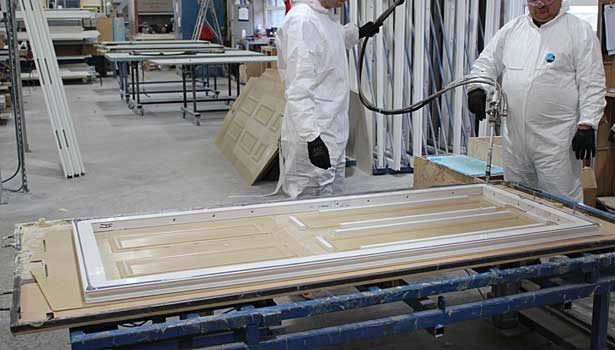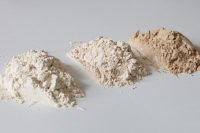Structural adhesives are allowing higher performance composite doors to be produced more cost effectively.
The right type of structural adhesive can produce a lower weight assembled part with superior mechanical performance characteristics such as improved flexural strength, better creep properties and higher impact resistance. These are compelling enough reasons for a manufacturing company to economically justify making design changes and rethinking production methods. The added commercial benefits of major productivity gains and overall lower production costs have convinced a number of companies to invest time and engineering resources to trial Crystic® Crestabond® and discover the performance improvements and significant cost savings they could achieve.
FASTER PRODUCTION
New World Ltd., based in Ballymena, Northern Ireland, is a leading manufacturer of exterior and interior unplasticized polyvinyl chloride (UPVC) and glass-reinforced plastic (GRP) composite domestic doors. The company has an established customer base in the UK and Ireland, which is currently expanding with growing export sales in Europe and the U.S. In this highly competitive sector of the building market, New World needs to be extremely cost and productivity focused, without any compromises on build quality.
With this in mind, after successful shop floor production trials, Crestabond M1-05 was specified for key inner sash frame and door skin structural bonding applications. Since mid-2011, Crestabond M1-05 has been phased in and is now used on 85% of New World’s range of doors. This includes the new all-GRP Apeer 70 and 44 doors, which are constructed with a bonded inner sash made from a pultruded GRP profile. (The advantage of having the entire door designed with the same material is the elimination of any distortion following installation.)
The switch to using Crestabond M1-05 to bond together the cut-to-size GRP or UPVC profiles that are used to make the rectangular inner sash frame of the door designs has had a major impact on increasing New World’s overall production line productivity and build quality, as well as reducing scrap levels. “With Crestabond M1-05, due to its significantly faster fixture time, we have made significant productivity gains in our door production,” explains Asa McGillian, managing director of New World. “The overall cost benefit analysis is commercially very attractive for the business relative to the price of Crestabond.”
For the pultruded GRP inner sash frames, New World now has a 25% faster cycle time in the bond and assembly stage, down from 16 to only 12 minutes. Productivity gains were even better for the UPVC inner sash production line, where the cycle time has been reduced by 73% since switching to Crestabond M1-05. With its 12-min fixture time, Crestabond M1-05 replaced a two-part polyurethane (PU) adhesive that required 45 min before the assembled frame could be moved to the next production stage.
“Product quality has definitely improved, particularly during colder periods, as Crestabond has proved to be a tougher, more reliable and consistent adhesive, which gives us fewer breakages and scrap loss compared with other MMA and polyurethane adhesives previously used,” says McGillian.
To help with productivity, New World uses automated 10:1 dispensing machines from UK equipment manufacturer Liquid Control Ltd. in combination with 20-liter pails of Crestabond M1-05. However, for certain bonding applications, such as a 4-mm profile, using a handheld pneumatic gun with 400-ml cartridges of Crestabond has proved faster to use. This method also offers better application control of small beads of adhesive, which produces less waste. New World has found that using cartridges is overall more cost effective for smaller, more intricate bonding applications. New World also molds its higher performance and fire-resistant GRP door skin panels using Scott Bader’s Crestapol® 1210 resin, which results in higher product performance and productivity.
FULL RANGE
The Crestabond range of primer-less methyl methacrylate (MMA) structural adhesives offers a cost-effective alternative bonding solution to the growing demand for better, faster performing universal structural adhesives capable of bonding not only composites, but also commonly used metal and plastic substrates such as aluminum, stainless steel, acrylonitrile butadiene styrene (ABS), acrylic, and polycarbonate (PC).
The Crestabond range is aimed at manufacturers in the bus, truck, rail, construction, marine and wind energy markets looking for a tough, cost-effective, high-performance bonding and gap filling structural adhesive with long-term reliability. An additional production benefit is improved shop floor working conditions; using an adhesive for assembly rather than over-laminating eliminates grinding dust, reduces styrene emissions and provides a cleaner shop floor environment.
All Crestabond adhesives in the current range have a 10:1 mix ratio, supplied in a choice of pack sizes from 400-ml coaxial cartridges, which can be applied using manual or pneumatic hand gun applicators, to bulk pack sizes in 20-liter (18-kg) pails or 200-liter (180-kg) drums for use with proprietary dosing machines.
For more information, visit www.scottbader.com/adhesives. New World’s website is located www.nwd.uk.com.
ABOUT SCOTT BADER
Established in 1921, Scott Bader is a £200 million (approximately $320 million) multinational chemical company that employs 600 people worldwide. It is a common trusteeship company with no external shareholders and a strong commitment to supporting its customers, workforce, and the environment. Scott Bader’s headquarters in the UK features purpose-built, state-of-the-art technical facilities that accommodate R&D and complete evaluation, testing, and application support. The company also has manufacturing facilities in the UK, France, Croatia, the Middle East and South Africa.


